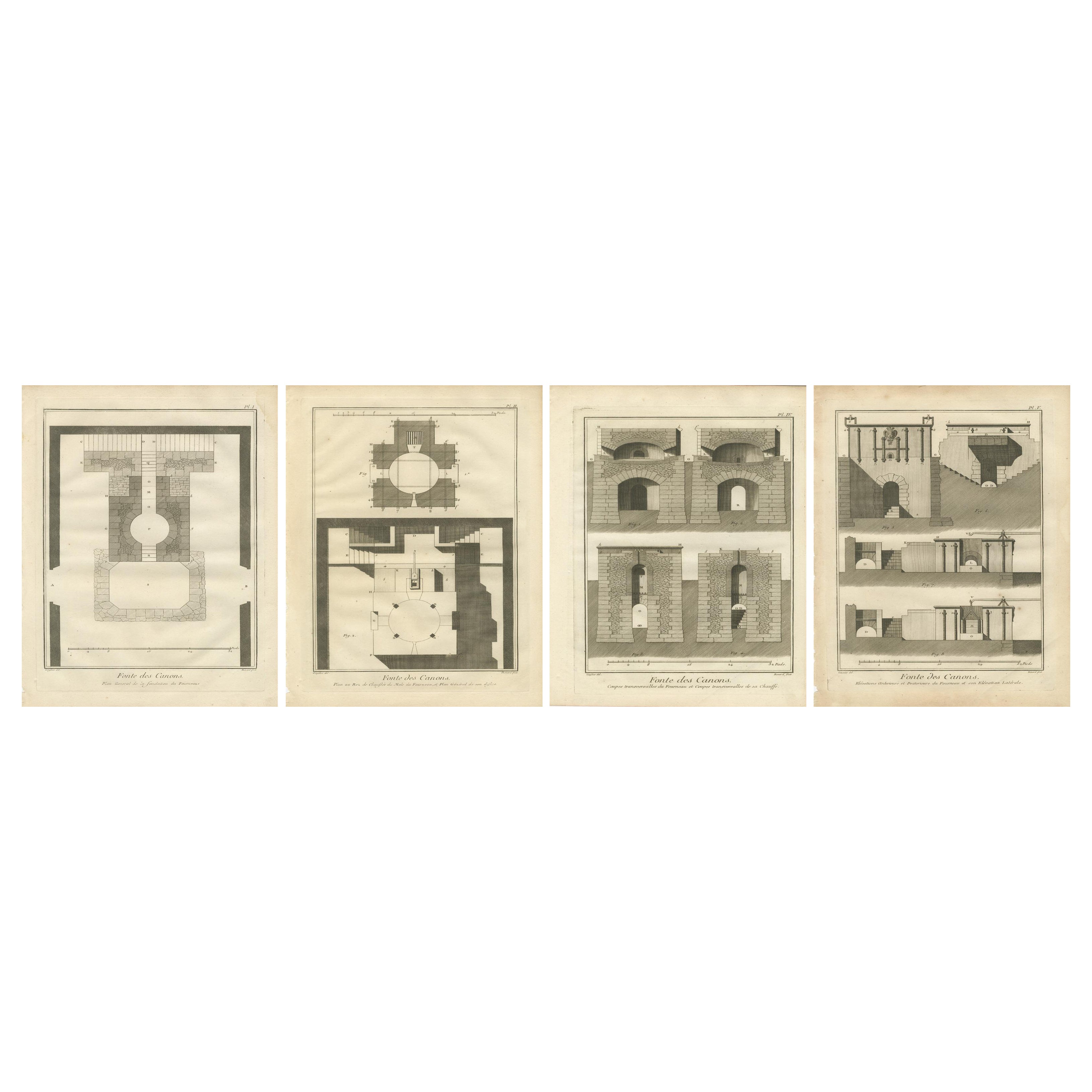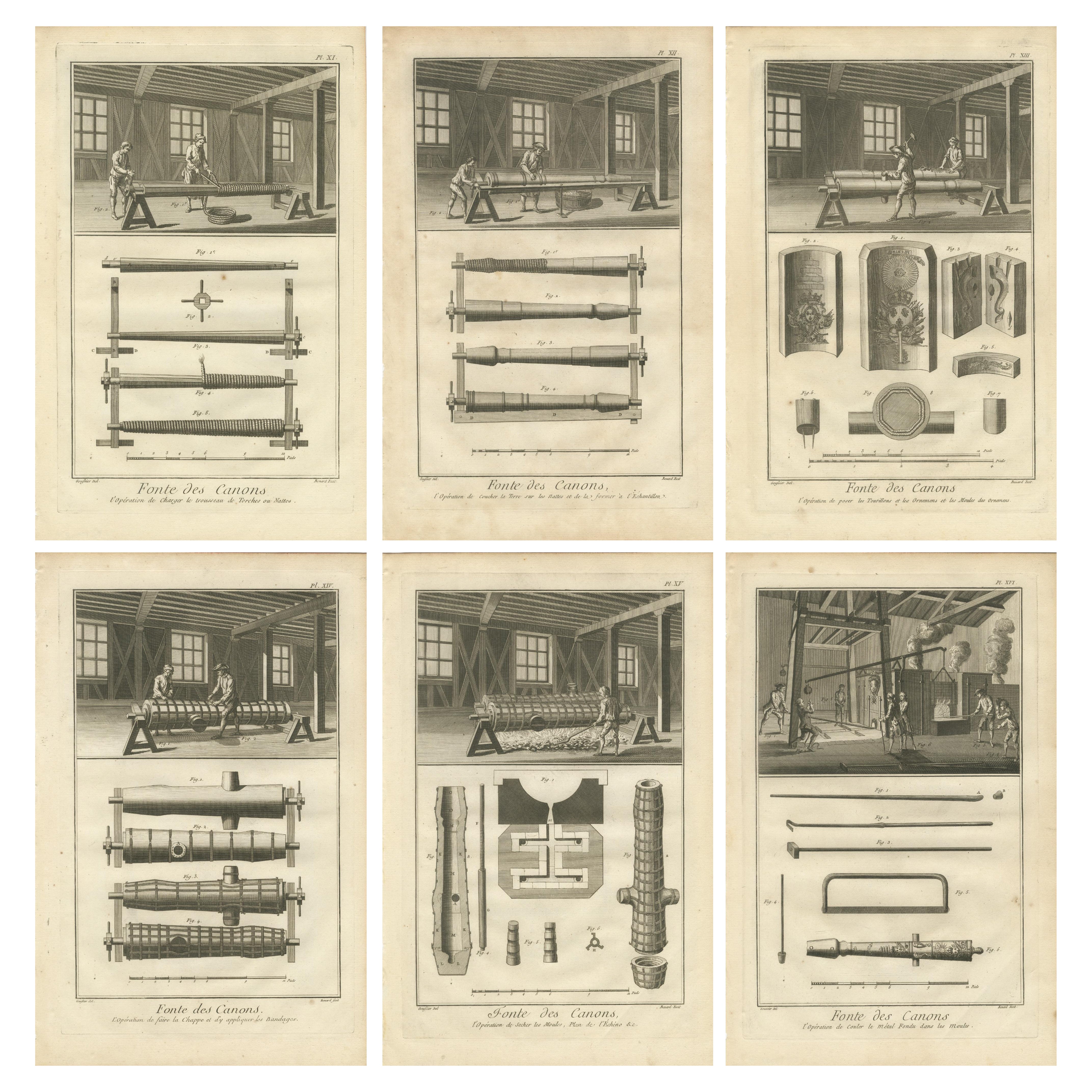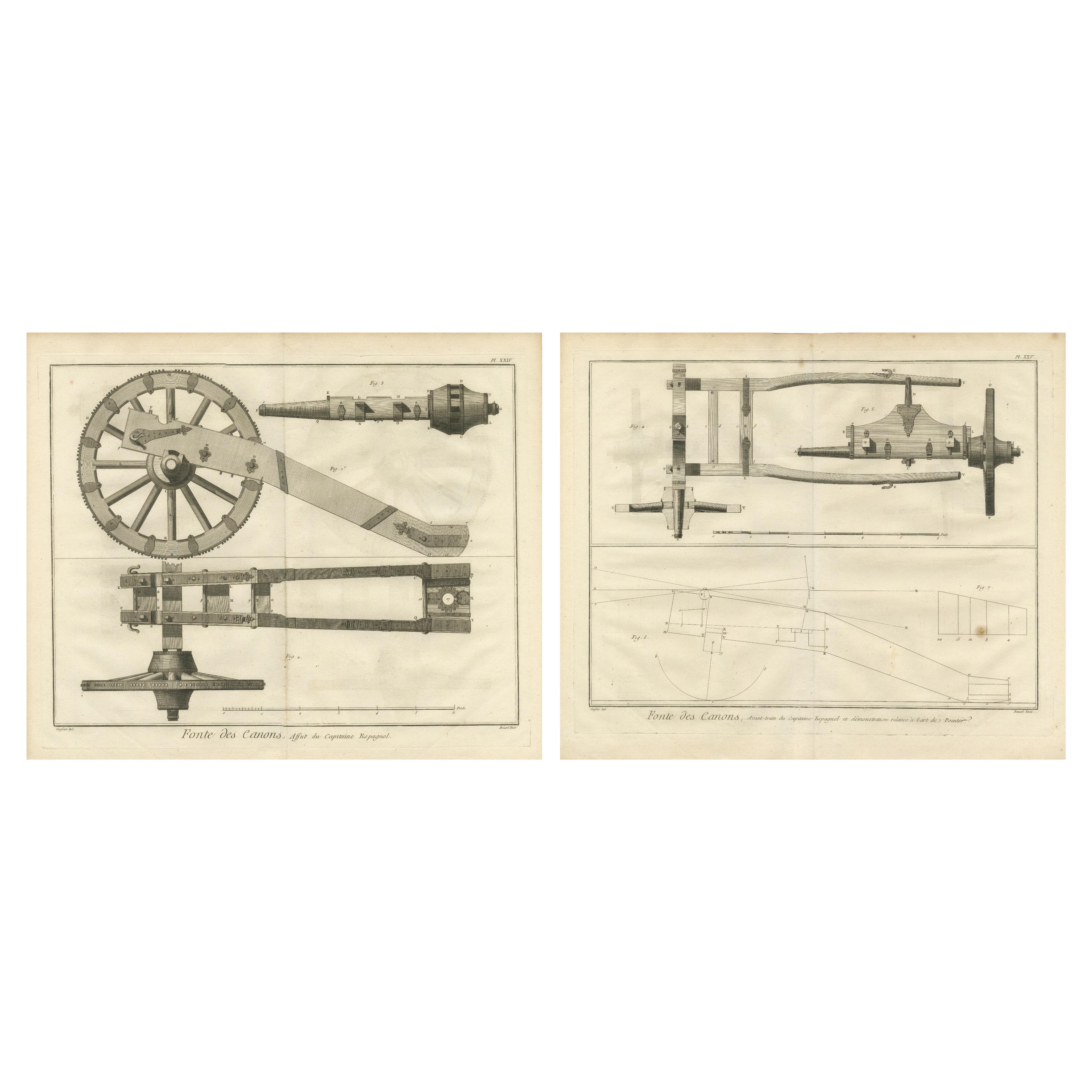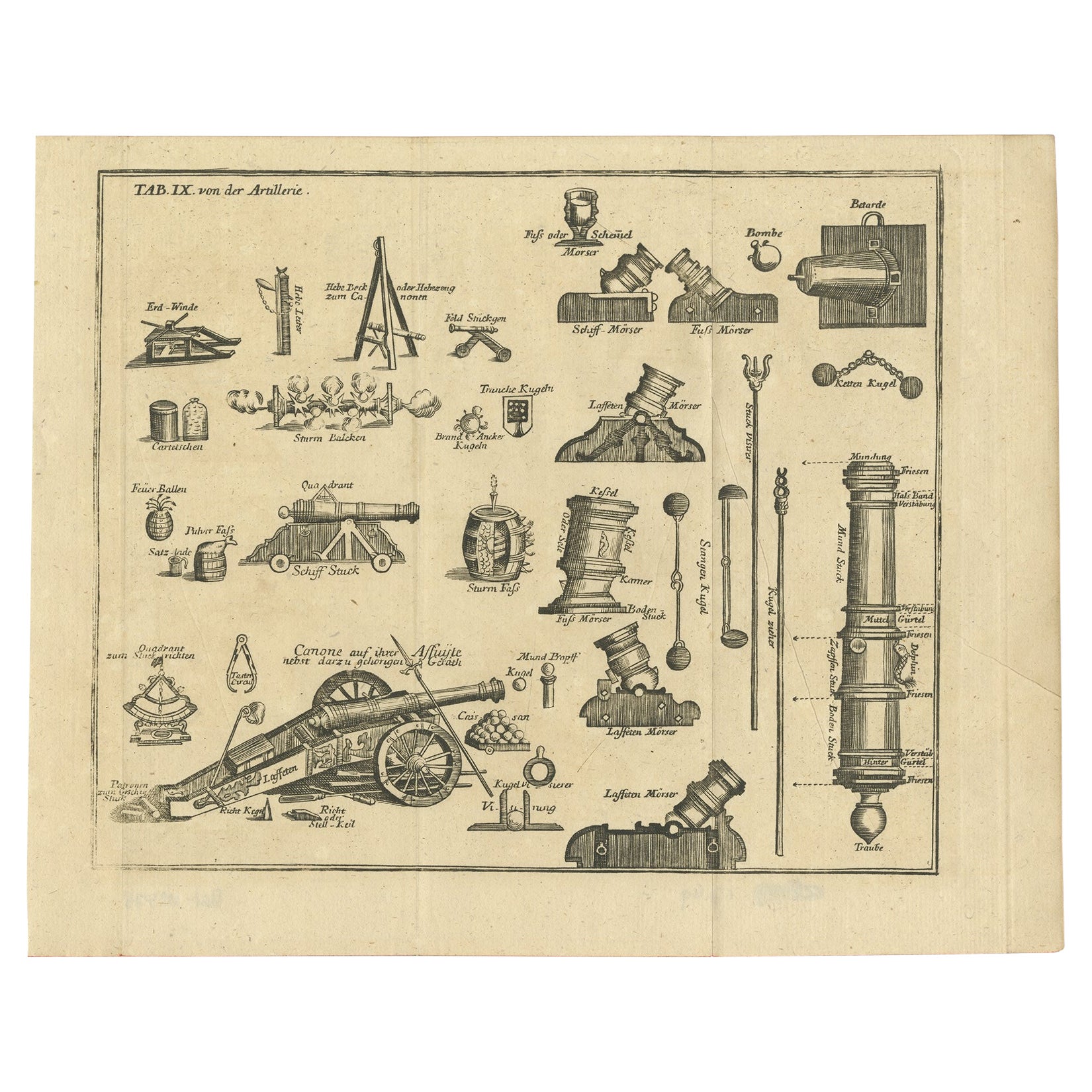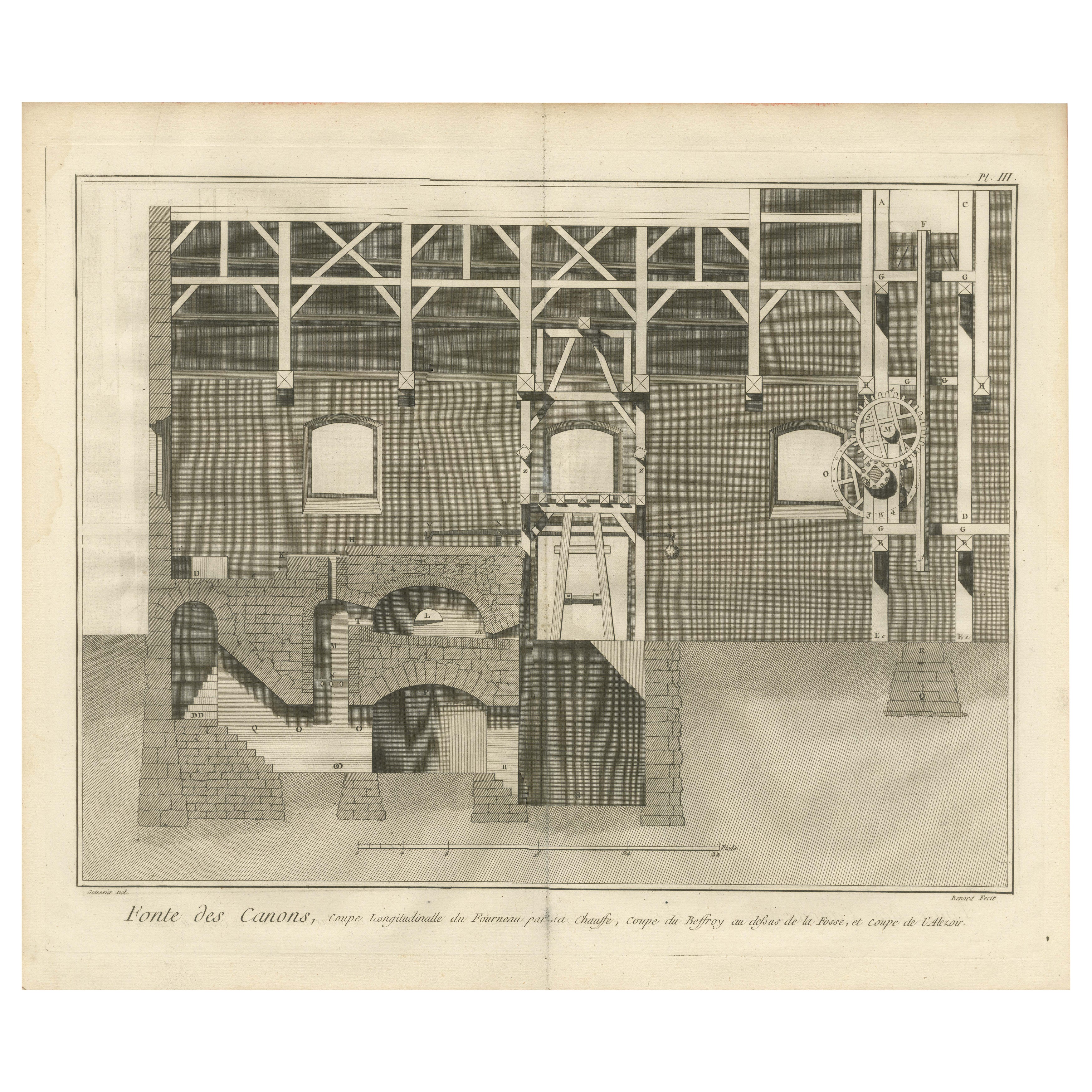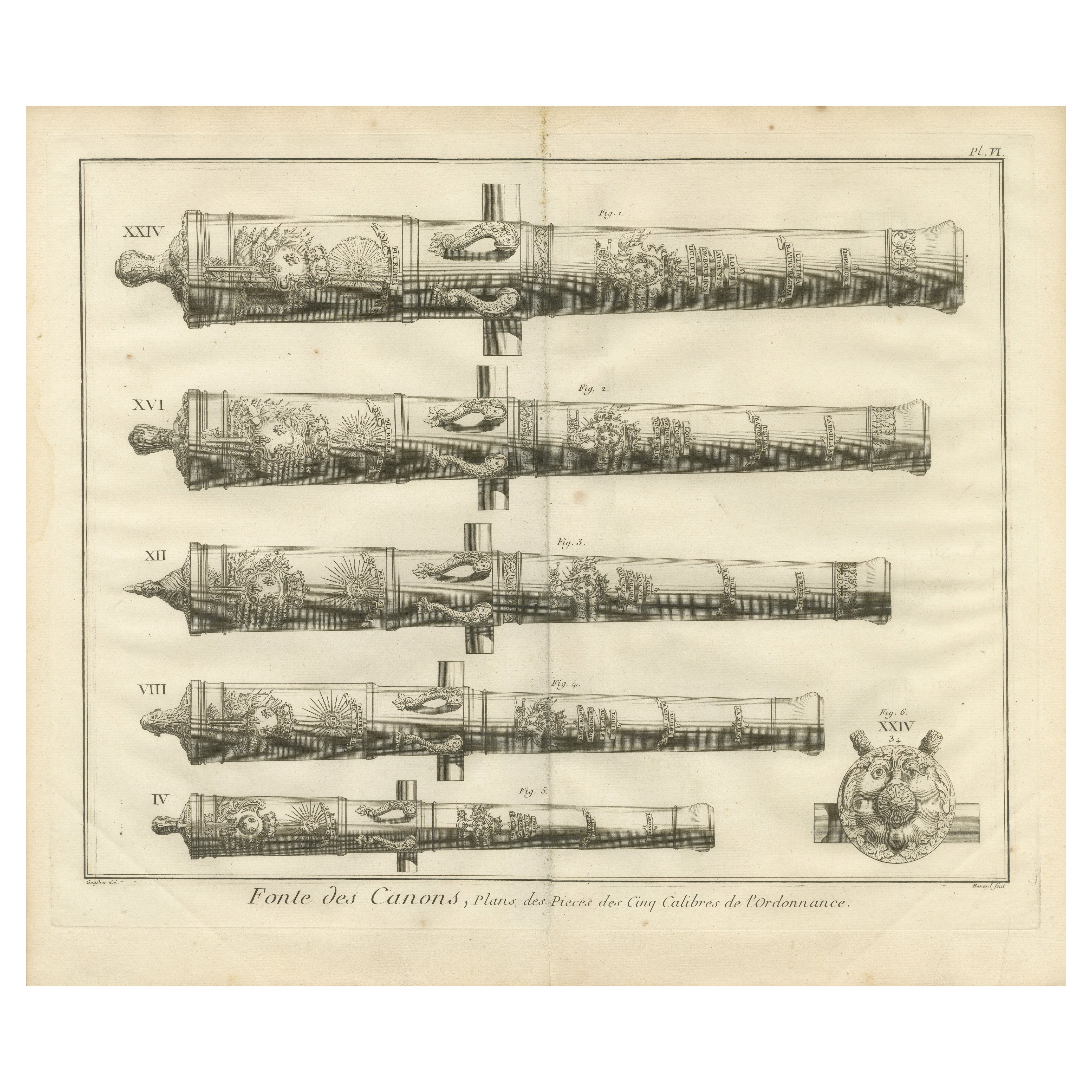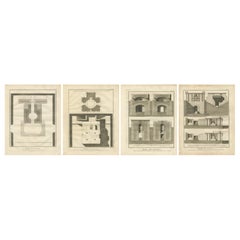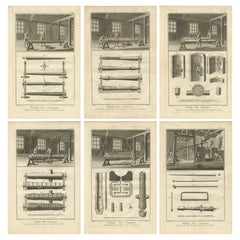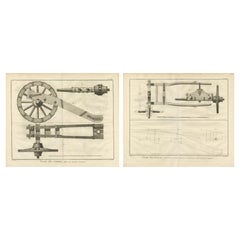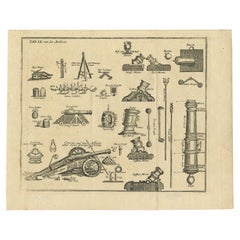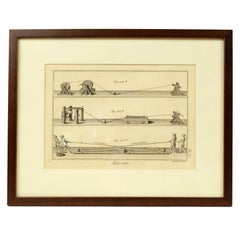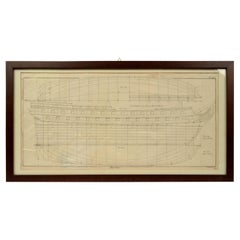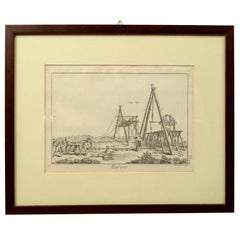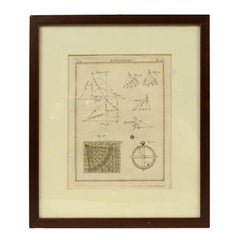Items Similar to Antique 18th Century Engraving of Cannon Designs and Cross-Sections from Diderot
Want more images or videos?
Request additional images or videos from the seller
1 of 10
Antique 18th Century Engraving of Cannon Designs and Cross-Sections from Diderot
$277.03per set
$346.29per set20% Off
£205.04per set
£256.30per set20% Off
€232per set
€290per set20% Off
CA$383.24per set
CA$479.05per set20% Off
A$427.05per set
A$533.82per set20% Off
CHF 222.37per set
CHF 277.97per set20% Off
MX$5,153.93per set
MX$6,442.42per set20% Off
NOK 2,787.98per set
NOK 3,484.97per set20% Off
SEK 2,634.28per set
SEK 3,292.85per set20% Off
DKK 1,766.43per set
DKK 2,208.03per set20% Off
About the Item
Title: Antique 18th Century Engraving of Cannon Designs and Cross-Sections from Diderot
Description: This original 18th-century engraving presents highly detailed technical illustrations of cannon designs, including precise cross-sections and schematics, meticulously drawn for Diderot's famous Encyclopédie, ou Dictionnaire raisonné des sciences, des arts et des métiers. This set of engravings showcases the artistic and scientific advancements in artillery manufacturing during the Age of Enlightenment. These plates were executed by skilled engravers under the guidance of Denis Diderot and Jean-Baptiste Le Rond d'Alembert, and were intended to document the most sophisticated foundry techniques and cannon designs of the period.
The engraving consists of two large plates, carefully arranged in a horizontal composition. The first plate illustrates the longitudinal sections of five different calibers of cannons, highlighting the internal structure and bore diameter, crucial for understanding the precision of artillery production in the 18th century. Each cannon is meticulously labeled with numerical values indicating scale, proportions, and mechanical specifications. The second plate presents schematic elevations of the same five calibers, including precise dimensional annotations and intricate decorative elements found on the breech and muzzle. The engravings feature elaborate embellishments, such as royal insignia, intricate floral motifs, and ornate cartouches, which were characteristic of high-status artillery pieces cast for European monarchies.
These plates serve as an important historical record of 18th-century metallurgy, engineering, and military technology. Cannon design was not only a matter of warfare but also a demonstration of national prestige and technological superiority. The detailed line work and shading techniques used in these engravings reflect the exceptional skill of the engraver and the commitment to scientific accuracy. These images were invaluable resources for craftsmen, military engineers, and scholars of the period, offering a visual guide to the principles of cannon casting and the intricacies of foundry work.
Condition Report:
The engravings are in very good condition considering their age, with only minimal foxing and light toning visible around the margins. The paper has retained its integrity, with no significant tears or creases affecting the printed area. The impressions are crisp and well-defined, with excellent contrast that preserves the fine detailing of the original plates. Some slight discoloration is present along the edges, which is consistent with the natural aging of antique paper.
Framing Tips:
To properly display and protect this engraving, it is recommended to use archival-quality materials. A museum-grade mat with an acid-free backing will help preserve the paper and prevent further aging. A simple yet elegant black or dark wood frame will complement the engraving's historical and technical nature without overshadowing its intricate details. For additional protection, consider UV-resistant glass or acrylic to prevent fading from light exposure. This engraving would be an excellent addition to a study, library, or collection focused on military history, engineering, or 18th-century scientific advancements.
- Dimensions:Height: 15.67 in (39.8 cm)Width: 20.48 in (52 cm)Depth: 0.01 in (0.2 mm)
- Sold As:Set of 2
- Materials and Techniques:Paper,Engraved
- Period:1770-1779
- Date of Manufacture:circa 1770
- Condition:Good condition considering their age, with only minimal foxing and light toning visible around the margins and folding lines. The paper has retained its integrity, with no significant tears or creases affecting the printed area.
- Seller Location:Langweer, NL
- Reference Number:Seller: BG-13998-7, -81stDibs: LU3054343935672
About the Seller
5.0
Recognized Seller
These prestigious sellers are industry leaders and represent the highest echelon for item quality and design.
Platinum Seller
Premium sellers with a 4.7+ rating and 24-hour response times
Established in 2009
1stDibs seller since 2017
2,588 sales on 1stDibs
Typical response time: <1 hour
- ShippingRetrieving quote...Shipping from: Langweer, Netherlands
- Return Policy
Authenticity Guarantee
In the unlikely event there’s an issue with an item’s authenticity, contact us within 1 year for a full refund. DetailsMoney-Back Guarantee
If your item is not as described, is damaged in transit, or does not arrive, contact us within 7 days for a full refund. Details24-Hour Cancellation
You have a 24-hour grace period in which to reconsider your purchase, with no questions asked.Vetted Professional Sellers
Our world-class sellers must adhere to strict standards for service and quality, maintaining the integrity of our listings.Price-Match Guarantee
If you find that a seller listed the same item for a lower price elsewhere, we’ll match it.Trusted Global Delivery
Our best-in-class carrier network provides specialized shipping options worldwide, including custom delivery.More From This Seller
View AllSet of 1770s Cannon Foundry Engravings from Diderot’s Encyclopédie, France
Located in Langweer, NL
Title: Set of 1770s Cannon Foundry Engravings from Diderot’s Encyclopédie, France
Description: This set of eighteenth-century engravings, titled Fonte des Canons, originates from ...
Category
Antique 1770s Prints
Materials
Paper
$277 Sale Price / set
20% Off
Rare Engravings Depicting the Intricate Process of Cannon Manufacturing, ca.1770
Located in Langweer, NL
Rare 18th-century engravings depicting the intricate process of cannon manufacturing
This compilation of six detailed 18th-century engravings showcases the fascinating and comple...
Category
Antique 1770s Prints
Materials
Paper
18th-Century Artillery Engraving of the Spanish Captain's Carriage and Mechanism
Located in Langweer, NL
Title: 18th-Century Artillery Engraving of the Spanish Captain's Carriage and Mechanisms
Description: This highly detailed 18th-century engraving presents a meticulously rendered...
Category
Antique 1770s Prints
Materials
Paper
Antique Engravring of Different Artillery like Bullets, Cannons, Bombs, c.1769
Located in Langweer, NL
Antique print titled ‚Tab IX. von der Artillerie‘.
This print depicts many different artillery like bullets, cannons, bombs and many more. German subtitles.
Artists and Engra...
Category
Antique 1760s Prints
Materials
Paper
$219 Sale Price
20% Off
18th Century Cannon Foundry Engraving from Diderot’s Encyclopédie, circa 1770
Located in Langweer, NL
18th Century Cannon Foundry Engraving from Diderot’s Encyclopédie, circa 1770
This fine 18th-century engraving, titled Fonte des Canons, origin...
Category
Antique 1770s Prints
Materials
Paper
18th Century Engraving of Ornate French Cannons, circa 1770
Located in Langweer, NL
18th Century Engraving of Ornate French Cannons from Diderot’s Encyclopédie, circa 1770
This exceptional 18th-century engraving, titled Fonte des Cano...
Category
Antique 1770s Prints
Materials
Paper
You May Also Like
Engraving Print from the Panckoucke Encyclopédie Nautical Subject, 1782-1832
Located in Milan, IT
Print by engraving on copper plate from the Panckoucke Encyclopédie méthodique, end of the 18th century, volume Marine Planches (more than 1,500 figures dealing with all subjects on the marina: planes, construction, carpentry, tree trunks, armaments of maneuvers, ropes, sails, artillery, ship maneuvers and combat tactics). This is the plate no. n. 26, pag. 70 fig. 350-353; with frame cm 38.3 x 31.5. Ship ropes are depicted. The Print has the "Benard direxit...
Category
Antique 1790s French Nautical Objects
Materials
Paper
Old Nautical Print by Engraving on Copper Plate from the Panckoucke Encyclopédie
Located in Milan, IT
Print by engraving on copper plate from the Panckoucke Encyclopédie méthodique, end of the 18th century, volume Marine Planches (more than 1,500 figures dealing with all subjects on the marina: planes, construction, carpentry, tree trunks, armaments of maneuvers, ropes, sails, artillery, ship maneuvers and combat tactics). This is the plate n. 149, page. 166 fig. 1209-1212; with frame cm 57.8 x 31.8. The prospect of the side of a ship is depicted. The Print has the "Benard direxit...
Category
Antique 1790s French Prints
Materials
Paper
Engraving Print from the Panckoucke Encyclopédie Nautical Subject 1782-1832
Located in Milan, IT
Print by engraving on copper plate from the Panckoucke Encyclopédie méthodique, end of the 18th century,volume Marine Planches (more than 1,500 figures dealing with all subjects on the marina: planes, construction, carpentry, tree trunks, armaments of maneuvers, ropes, sails, artillery, ship maneuvers and combat tactics). This is the plate no. n. 24, pag. 69 fig. 341 ; with frame cm 38.3 x 31.5. Ship ropes are depicted. The Print has the "Benard direxit...
Category
Antique 1790s French Nautical Objects
Materials
Paper
Engraving on Copper Print from the Volume Navigazione Nautical Subject 1790
Located in Milan, IT
Print by engraving on copper plate Tav III TIX fig. 17-22 from the volume Navigazione; with frame 28 x 33. Some calculations are depicted. Very good condition.
Shipping is insured by...
Category
Antique 1790s Italian Nautical Objects
Materials
Paper
Maniere de Prendre Les Mesures, Roubo French cabinetmaking design engraving
Located in Melbourne, Victoria
'Maniere de Prendre Les Mesures de la Menuiserie et de la Marquer sur le Plan'
French copper-line engraving by Berthault after Andre Jacob Roubo (1739–1791). 18th century laid water...
Category
Late 18th Century French School Interior Prints
Materials
Engraving
18th Century Napoleonic Egyptian Etchings
Located in Los Angeles, CA
Commissioned by Napolean the Etchings were Created by His Artist Upon His Invasion of Egypt. Set of 3.
Middles: 48"W x 33 1/2"H, Sides: 27"W x 33.5"H
Gilded Frames with 12K White ...
Category
Antique 18th Century and Earlier French Drawings
Materials
Textile, Paper
$9,780 / set
More Ways To Browse
Insignia Furniture
Military Cannon
Victorian Bulldog
Victorian Hand Belt
Victorian Iron Bed Frame
Vintage Ceramic Girl Figurines
Vintage Ceramic Mushrooms
Vintage Ceramic Rabbits
Vintage Concrete Tiles
Vintage Felt Doll
Vintage Glass Dressing Table Set
Vintage Glass Mannequin Head
Vintage Grape Boxes
Vintage Inuit Carvings
Vintage Lucite Mcm
Vintage Owl Ornaments
Vintage Porcelain Babies
Vintage Slipcovers
